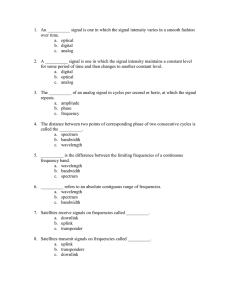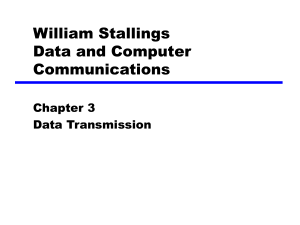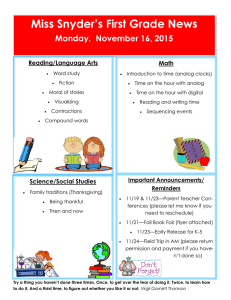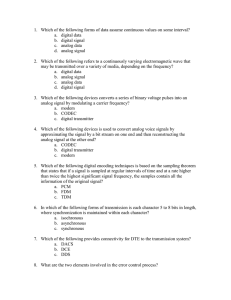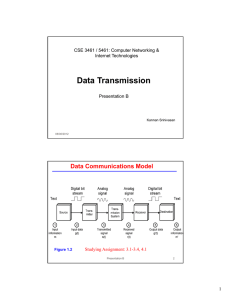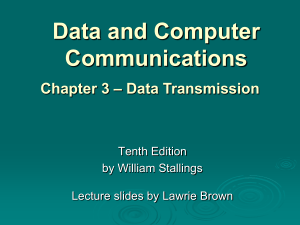William Stallings Data and Computer Communications Chapter 3
advertisement
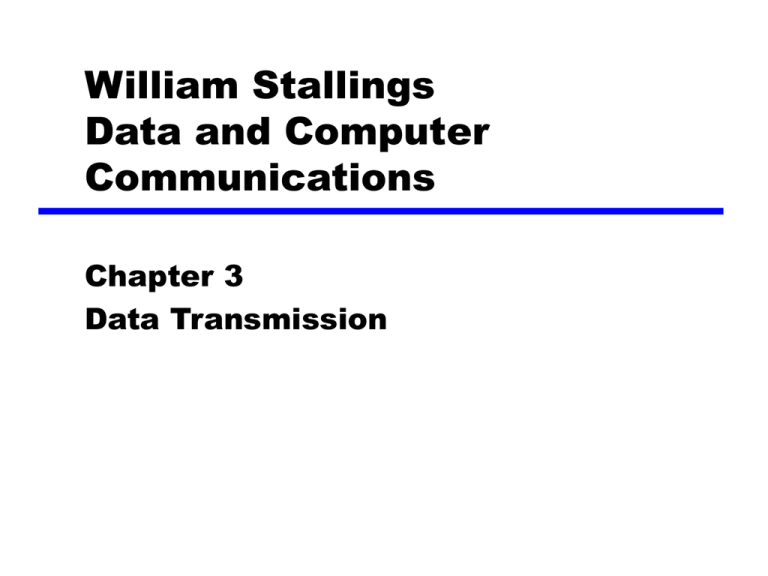
William Stallings Data and Computer Communications Chapter 3 Data Transmission Terminology (1) Transmitter Receiver Medium Guided medium e.g. twisted pair, optical fiber Unguided medium e.g. air, water, vacuum Terminology (2) Direct link No intermediate devices Point-to-point Direct link Only 2 devices share link Multi-point More than two devices share the link Terminology (3) Simplex One direction e.g. Television Half duplex Either direction, but only one way at a time e.g. police radio Full duplex Both directions at the same time e.g. telephone Frequency, Spectrum and Bandwidth Time domain concepts Continuous signal Various in a smooth way over time Discrete signal Maintains a constant level then changes to another constant level Periodic signal Pattern repeated over time Aperiodic signal Pattern not repeated over time Continuous & Discrete Signals Periodic Signals Sine Wave Peak Amplitude (A) maximum strength of signal volts Frequency (f) Rate of change of signal Hertz (Hz) or cycles per second Period = time for one repetition (T) T = 1/f Phase () Relative position in time Varying Sine Waves Wavelength Distance occupied by one cycle Distance between two points of corresponding phase in two consecutive cycles Assuming signal velocity v = vT f = v c = 3*108 ms-1 (speed of light in free space) Frequency Domain Concepts Signal usually made up of many frequencies Components are sine waves Can be shown (Fourier analysis) that any signal is made up of component sine waves Can plot frequency domain functions Addition of Frequency Components Frequency Domain Spectrum & Bandwidth Spectrum range of frequencies contained in signal Absolute bandwidth width of spectrum Effective bandwidth Often just bandwidth Narrow band of frequencies containing most of the energy DC Component Component of zero frequency Signal with DC Component Data Rate and Bandwidth Any transmission system has a limited band of frequencies This limits the data rate that can be carried Analog and Digital Data Transmission Data Entities that convey meaning Signals Electric or electromagnetic representations of data Transmission Communication of data by propagation and processing of signals Data Analog Continuous values within some interval e.g. sound, video Digital Discrete values e.g. text, integers Acoustic Spectrum (Analog) Signals Means by which data are propagated Analog Continuously variable Various media wire, fiber optic, space Speech bandwidth 100Hz to 7kHz Telephone bandwidth 300Hz to 3400Hz Video bandwidth 4MHz Digital Use two DC components Data and Signals Usually use digital signals for digital data and analog signals for analog data Can use analog signal to carry digital data Modem Can use digital signal to carry analog data Compact Disc audio Analog Signals Carrying Analog and Digital Data Digital Signals Carrying Analog and Digital Data Analog Transmission Analog signal transmitted without regard to content May be analog or digital data Attenuated over distance Use amplifiers to boost signal Also amplifies noise Digital Transmission Concerned with content Integrity endangered by noise, attenuation etc. Repeaters used Repeater receives signal Extracts bit pattern Retransmits Attenuation is overcome Noise is not amplified Advantages of Digital Transmission Digital technology Low cost LSI/VLSI technology Data integrity Longer distances over lower quality lines Capacity utilization High bandwidth links economical High degree of multiplexing easier with digital techniques Security & Privacy Encryption Integration Can treat analog and digital data similarly Transmission Impairments Signal received may differ from signal transmitted Analog - degradation of signal quality Digital - bit errors Caused by Attenuation and attenuation distortion Delay distortion Noise Attenuation Signal strength falls off with distance Depends on medium Received signal strength: must be enough to be detected must be sufficiently higher than noise to be received without error Attenuation is an increasing function of frequency Delay Distortion Only in guided media Propagation velocity varies with frequency Noise (1) Additional signals inserted between transmitter and receiver Thermal Due to thermal agitation of electrons Uniformly distributed White noise Intermodulation Signals that are the sum and difference of original frequencies sharing a medium Noise (2) Crosstalk A signal from one line is picked up by another Impulse Irregular pulses or spikes e.g. External electromagnetic interference Short duration High amplitude Channel Capacity Data rate In bits per second Rate at which data can be communicated Bandwidth In cycles per second of Hertz Constrained by transmitter and medium Required Reading Stallings chapter 3

